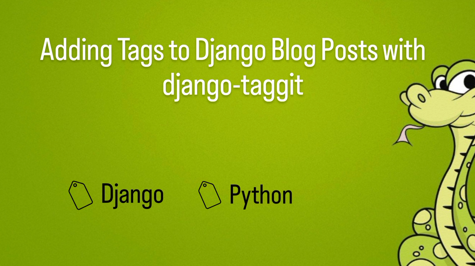Tags are a valuable feature in a blog application that allows users to categorize and organize their content effectively. In this step-by-step guide, we will explore how to integrate tags into a Django blog using the django-taggit library. This library simplifies the process of adding and managing tags in Django models.
Step 1: Install django-taggit
To get started, ensure that you have django-taggit installed in your Django project. You can easily install it using pip:
pip install django-taggit
Step 2: Add 'taggit' to your Django project
Once django-taggit is installed, include it in the INSTALLED_APPS list within your Django project's settings.py file:
INSTALLED_APPS = [
# ...
'taggit',
# ...
]
Step 3: Update the database
With django-taggit added to your project, create the required database tables by running migrations:
python manage.py migrate
Step 4: Add TaggableManager to your Blog model
Assuming you have a Blog model in your Django app, you'll need to import TaggableManager from taggit.models and add it to your model:
from django.db import models
from taggit.managers import TaggableManager
class Blog(models.Model):
title = models.CharField(max_length=100)
content = models.TextField()
tags = TaggableManager()
def __str__(self):
return self.title
Step 5: Update and create migrations
Generate and apply the migrations for your app to reflect the changes to the Blog model:
python manage.py makemigrations your_app_name
python manage.py migrate
Step 6: Use tags in your views and templates
Now that tags are integrated into your Blog model, you can use them in your views and templates. When creating or editing a blog post, you can include the tags field in the form.
In your views.py, when creating or editing a blog post, make sure to include the tags field in the form:
from django.shortcuts import render, redirect
from .forms import BlogForm
def create_blog(request):
if request.method == 'POST':
form = BlogForm(request.POST)
if form.is_valid():
blog = form.save()
# Do something with tags if needed
return redirect('blog_detail', pk=blog.pk)
else:
form = BlogForm()
return render(request, 'create_blog.html', {'form': form})
Step 7: Display tags in your blog detail view
To display the tags associated with a blog post, access the tags attribute of the Blog model:
<h1>{{ blog.title }}</h1>
<p>{{ blog.content }}</p>
<p>Tags: {% for tag in blog.tags.all %}{{ tag }}{% if not forloop.last %}, {% endif %}{% endfor %}</p>
Step 8: Adding tags to existing blog posts
If you have existing blog posts and want to add tags to them, you can do so through the Django admin interface or by writing a script to update the tags programmatically.
In your app's admin.py file, import the Blog model and the admin module, and then register the model with the admin site.
Step 9: Displaying tagged blog posts
To display blog posts with specific tags, create a view and template that filter the blog posts based on the selected tag(s).
In views.py, create a view to retrieve blog posts with a specific tag:
from django.shortcuts import render
from .models import Blog
def tagged_blogs(request, tag_slug):
tagged_blogs = Blog.objects.filter(tags__slug=tag_slug)
return render(request, 'tagged_blogs.html', {'tagged_blogs': tagged_blogs})
Step 10: Create the template to display tagged blogs
Create a template named tagged_blogs.html in your app's templates directory to display blog posts with a specific tag.
<h1>Blog Posts with Tag "{{ tag_slug }}"</h1>
<ul>
{% for blog in tagged_blogs %}
<li>
<a href="{% url 'blog_detail' pk=blog.pk %}">{{ blog.title }}</a>
<p>{{ blog.content }}</p>
</li>
{% endfor %}
</ul>
Step 11: Create a URL pattern to access tagged blogs
Create a URL pattern in your app's urls.py file to link to the tagged_blogs view:
from django.urls import path
from . import views
urlpatterns = [
# ... other URL patterns ...
path('tagged/<slug:tag_slug>/', views.tagged_blogs, name='tagged_blogs'),
]
By following these steps, you can successfully add tags to your Django blog posts using the django-taggit library. This enhances the organization and discoverability of your blog content, providing a more user-friendly experience for your readers.




